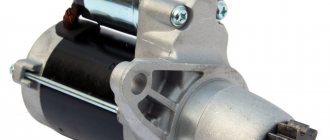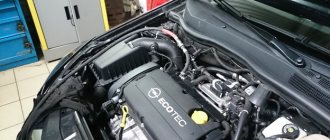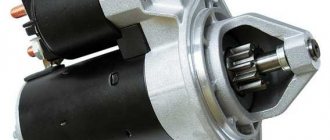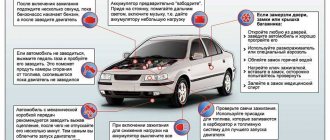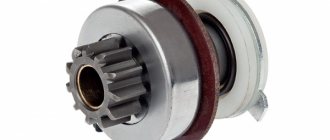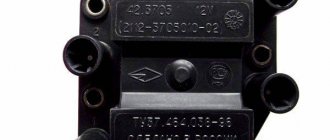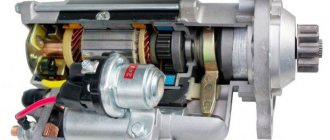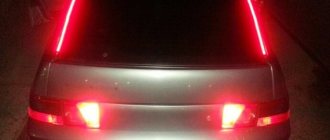Even experienced motorists complain that the VAZ-2114 does not start and the starter does not turn. What are the causes of this problem and how can it be solved? To understand this, read our article, which provides detailed expert advice on solving the described problem.
What is a starter on a VAZ-2114
The starter is one of the main elements of an internal combustion engine. Its function is to drive the crankshaft in the power plant. It does this until the fuel mixture ignites. As soon as this happens, the camshaft will immediately begin to spin on its own, and the car will start.
In normal mode, the VAZ-2114 starter begins its work as soon as the driver turns the key. The entire process can take less than a minute – about fifteen seconds. If this mechanism experiences increased loads during vehicle operation, it may quickly fail and not start. Therefore, it is very important to ensure that the electric starter is in good condition and is correctly attached to the engine block.
Possible reasons why the starter does not turn and how to eliminate them
Experts name several reasons as a result of which the starter stops turning and the car stops starting. The first, most common, is when the battery is discharged. It can discharge in many cases. For example, if the driver does not turn off the lighting devices in the vehicle for a sufficiently long period. This situation can be encountered especially often during winter, when it gets dark early and you have to use additional lighting in the car.
It is easy to understand that the starter does not turn due to a discharged battery. Experts advise that while turning the ignition key, listen to how the relay operates - it will make a characteristic noise. In this case, you can use several methods to correct the situation:
- charge the battery;
- replace the battery;
- warm up the battery (if the problem occurred during the cold winter period);
- “light” her.
If you do all the above procedures one by one, then in one of the cases the car will definitely start.
The second common reason why the starter may not turn is the lack of ground on the solenoid relay. In such a situation, the owner of the VAZ-2114 needs to pay attention to how the negative wire from the solenoid relay is attached to the battery ground. If deviations from the norm are noticed, the following steps should be taken:
- the first step is to clean the terminal;
- the second step is to secure the ground to the solenoid relay.
Such actions will help the starter resume its functions, it will begin to spin, and the car will start.
Mechanical reasons why the starter may fail
The above problems associated with the operation of the starter are electrical in nature. But experts note a number of other reasons for the failure of this automobile part. They are mainly mechanical in nature. These include wear of the following parts:
- Drive gears (namely, their teeth).
- Overrunning clutch.
- Flywheel ring gear.
These malfunctions are united by one common characteristic feature - a metallic crackling sound when starting the internal combustion engine. Experts explain this phenomenon as follows: in good condition, the electric starter spins the flywheel with virtually no extraneous sounds. The driver will not hear any squeaks or whistles. As soon as these parts wear out, the starter, vigorously spinning the flywheel to start the valve-piston group, will begin to make extraneous sounds, which should alert the driver and make him think about repairing the vehicle.
Expert advice: checking the operation of the starter
To identify the reason why the starter does not turn, experts advise using the following instructions:
- We check the wire contacts on both the starter and the battery for oxidation of the wiring:
- clean the battery terminals;
- clean the electric starter contacts.
- Checking the battery charge:
- measure the capacity of the cans;
- its standard indicator is from 1.25;
- if the indicator is lower, then we simply charge the battery.
- We check the pull-in electrical winding of the relay to see if there is a short circuit between its turns:
- We replace the relay with a damaged electrical winding with a new one.
- We check the wiring supplying electric current to the relay on the starter for breaks:
- First we diagnose the electric motor plug;
- Then we diagnose the ignition switch plug.
- We check the ease of rotation of the electric starter armature (this can be done manually):
- If a short circuit occurs in its winding, replace it.
- Check to see if the manifold is burning:
- We replace the failed part.
In order for the VAZ-2114 to always start properly, the driver needs to carry out timely maintenance of the battery and electric starter, which are responsible for the smooth operation of the vehicle.
Dead battery
As a rule, a problem with starting the engine using a starter device does not arise without a reason. The condition of this unit should be checked regularly. The frequency of vehicle operation directly affects the service life of the device. Frequent engine starts gradually consume the starter's life.
Useful : Where is the starter fuse on the VAZ 2114?
Rarely driving a car can also lead to problems with normal starting of the car. A dead battery is a common and not the most serious reason for starter inactivity. Operating the car in home-work mode leads to the fact that the generator does not have time to restore the battery charge, which it spends on starting the engine.
There is only one symptom of starter inactivity due to a discharged battery - the retractor clicks. In order to verify this problem, you can turn on other electrical appliances in the car. You can also try to close the starter directly - using a thick screwdriver. If there is insufficient charge, the retractor will click and the starter will not operate. Now you have an understanding of why the starter clicks but does not turn. When considering the reasons why the VAZ 2114 starter does not turn, you should first check the condition of the battery. The most reliable test option is to use a multimeter to measure the current charge.
The starter does not turn over, what should I do?
In the life of owners of the VAZ-2114, and other cars close to this line (see above), sometimes such an unpleasant moment arises when you need to go somewhere, but it is not possible to start the power plant due to the fact that the starter does not turn the flywheel engine.
That is, when you turn the ignition key to the “start” position, nothing happens.
And if in the summer you can calmly look for the cause of the malfunction, then in the winter, in severe frost, you won’t spend much time searching for the malfunction. And in order to quickly fix a breakdown, you need to know where to look for it.
How to quickly start your car in cold weather, see below.
Ignition switch relief relay
In addition to the retractor relay on the housing of the starter device, its operating circuit includes another unloading relay, located under the hood or on the steering column. The main task of the unloading relay is to protect the device from overload. Often, replacing this element allows you to restore the starter's functionality.
Since the unloading relay is not much different from the standard elements that are located in the mounting block, to check its malfunction it is enough to install a similar relay for testing. If the starter starts turning, the problem is in this element. The reason for its failure is a voltage surge in the device circuit.
The main problem if this relay malfunctions can be finding it. Since the element was placed differently in cars of different years of production, when searching, take into account the following possible locations for installing the relay:
- Under the hood, near the vacuum booster;
- Under the steering column in conjunction with other wires;
- On the interior body panel under the car panel.
If replacing the relay did not help and the starter on the VAZ 2114 still does not turn, you should carry out further diagnostics.
Useful : Replacing the starter on a VAZ 2114 (step-by-step instructions)
Design
A car starter consists of many parts necessary for its operation. Its main parts are the rotor, stator and brush assembly. These parts are necessary to rotate the starter shaft, which engages with the ring. There is also a special electromagnetic relay on the starter that works to retract the armature. It is this that engages the bendix armature with the flywheel crown.
Poor mass of minus battery on the body
Because For the normal operation of any electrical appliance, the condition of all contacts and wiring is important - you should check the condition of the negative ground of the battery on the car body. Mechanical damage to the wiring or its destruction due to oxides often causes the starter to not work. The photo below shows the exact location of the battery negative ground wire on body 2114.
The rather inconvenient location of this wire leads to the fact that during manipulations with the battery it breaks. Loss of ground causes the starter device to fail to operate. To solve the problem, just screw a new ground wire onto the body and securely fix it. If, after replacing the ground wire, the VAZ 2114 does not start - the starter does not turn, you should investigate further.
Important ! In addition to the ground wire, you should check the condition of the chip on the starter itself. Unreliable contact fixation makes starting the motor through the starter device impossible.
Purpose
A starter is an electrical device that converts electrical energy into mechanical energy. The mechanical energy received from the starter is directed to rotate the crankshaft through the flywheel crown, thereby delivering the crankshaft speed necessary to start the engine. The starter receives power only from the battery and uses its energy only when the engine starts. When the engine starts, the starter does not consume any energy from the vehicle's on-board network. It is a kind of DC electric machine designed only to start the motor.
contact Group
To influence the starter, first of all, the driver turns the key in the ignition switch. The condition of this unit and wiring is also worth checking, especially if the starter does not operate when starting the engine. Damage to wires in the contact group is a common problem on domestic cars.
The status of the contact group can be checked in the following ways:
- Visually check the condition of the wiring and terminal blocks. Increased voltage on the node causes carbon deposits, melting of wires and burnout of the group tracks. In case of serious problems, these defects are visible to the naked eye;
- A more complex diagnostic method is to use a multimeter in ohmmeter mode. If there is no resistance on the device when the ignition is turned on, the contact group should be replaced.
For accurate diagnostics, you can install a known working contact group from a working machine.
PRICES AND MANUFACTURERS
Prices for starting devices may vary depending on the manufacturer and the design of the device itself. Among the product manufacturers we can note such companies as Pramo Iskra (a Russian-Slovenian joint venture), STARTVOLT, LKD (China), BATE (Belarus), PEKAR (St. Petersburg), KZATE (Samara), Avtopribor (Vladimir). Nowadays, you can increasingly find a gear starter on sale - it has an additional gear mechanism that allows the device to operate under increased loads. Such devices are smaller in size and have a longer service life, but their price may be slightly higher.
Below are approximate prices for some types of devices:
Starter manufacturer price table
At the VAZ plant they install a KZATE 5712.3708 starter manufactured in Samara. It is difficult to say whether it is the best in quality, but you can always buy spare parts for it. Many people praise Belarusian products, but problems often arise with spare parts - most often in stores only Bendix is sold as spare parts for it. It should be noted that the starters of VAZ 2108, VAZ 2109, VAZ 2113, VAZ 2114 and VAZ 2115 are no different from each other and are completely interchangeable.
If the starter on a VAZ 2114 does not turn, it is not at all necessary to remove it immediately. The fact is that the relay may be to blame for the malfunction, but not the retractor, but the one that is unloading and is usually installed either under the hood closer to the windshield, or under the steering shaft in the cabin. The relay is included in the electrical circuit running from the ignition switch to the VR, and is designed to protect the starter from overload.
But the question of where the starter relay is located on a VAZ 2114 often confuses many motorists, and this question is often asked on forums. The simple fact is that, depending on the year of manufacture of the car, the manufacturer slightly modified the electrical circuit and changed the arrangement of its elements. Then, when installing an alarm system, auto electricians could move the starter relay on the VAZ 2114 to another location.
How to find this tricky relay if it is not clear where it is located? It is necessary to remember how the connection diagram for the starter on the VAZ 2114 is arranged. There are only two supply wires on the VR - a constant voltage of 12 volts from the battery and a supply wire to the VR coming from the ignition switch. It is along the circuit of this wire from the starter that you need to follow, in the end, the wire will lead to the desired relay, in the diagram it is indicated as a locking switch.
Starter connection diagram
Depending on the year of manufacture and the engine control system, the relay might not be installed at all, for example, on cars produced before 2003. In cars produced before 2005, the relay block was installed in the engine compartment next to the vacuum brake booster.
Starter relay location
Later, on cars with a Europanel, this element was moved under the control panel, above the pedals in the cabin.
Egnition lock
Next, you need to understand how to check the ignition switch. This unit is directly related to starting the engine. The absence of an electrical circuit between the solenoid relay and the ignition switch is a common cause of malfunction.
In addition to externally inspecting the lock for damage, you can inspect the condition of the wiring inside the device body. Measuring resistance with an ohmmeter will also allow you to accurately determine the serviceability of the part. If it is not possible to turn on even the first position (ignition on) through the lock, then starting the starter directly will also not be possible. In such a situation, you should understand the wiring of the device and, if necessary, completely replace the part.
If you cannot turn the key in the lock, check the hole for foreign objects. If the key is stuck, you should call in specialists.
Mechanical reasons why the starter may fail
The above problems associated with the operation of the starter are electrical in nature. But experts note a number of other reasons for the failure of this automobile part. They are mainly mechanical in nature. These include wear of the following parts:
- Drive gears (namely, their teeth).
- Overrunning clutch.
- Flywheel ring gear.
These malfunctions are united by one common characteristic feature - a metallic crackling sound when starting the internal combustion engine. Experts explain this phenomenon as follows: in good condition, the electric starter spins the flywheel with virtually no extraneous sounds. The driver will not hear any squeaks or whistles. As soon as these parts wear out, the starter, vigorously spinning the flywheel to start the valve-piston group, will begin to make extraneous sounds, which should alert the driver and make him think about repairing the vehicle.
Solenoid relay
An important element in the engine starting device circuit is the solenoid relay. Its malfunction makes it impossible to start the engine in the standard way. Checking the functionality of the element is simple - if a characteristic clicking sound is not made when turning the key to the start position, the relay is faulty.
When the machine is idle for a long time, the mechanism in the device can become sour, so tapping on the body often solves the problem. If the element is completely faulty, the procedure for replacing the part is inevitable. For a convenient replacement procedure, it is better to remove the starter completely. As you can see, all problems with the starter device can be resolved on our own, so understanding all the intricacies of diagnosing breakdowns will help save time and money.
FAULTS
There are various signs of a starter malfunction on a VAZ 2114:
- The starter does not work at all, that is, it does not show any signs of life. The stator or rotor winding may burn out and power may not be supplied to the electrical part of the device;
- The starter turns, but does not engage; often the Bendix idles, not engaging with the flywheel. Usually the cause is the bendix itself - it should only rotate in one direction on its axis;
- The starter does not operate when the VAZ 2114 key is turned. If dry, quiet clicks occur, then both the VR solenoid relay and the relay responsible for turning on the circuit by turning the key in the ignition switch may be faulty. If the VR is faulty, the clicks are usually louder;
- The starter turns slowly, but can stop quickly. The stator or armature winding is short-circuited, the rotor has play in the bushings. There may also be a bad weight of the internal combustion engine with the body or a weak battery, but this does not apply to the starter;
- The engine starts with a grinding or crunching sound. Most often, such a start indicates wear of the teeth on the Bendix gear or the teeth of the engine flywheel.
Problem solving
Diagnostics, cleaning and lubrication of the starter
Based on the causes of malfunctions, their elimination is as follows:
- Charging or replacing the battery
- Clean the terminals and wire ends and lubricate them with Vaseline.
- Replacement: traction block, ignition switch contact, anchors.
- Cleaning: replacing relay or commutator contacts, brushes.
- Check the wire connections from the battery to the starter.
- Replacement of the coupling, if necessary, fixing the assembly, terminal contacts.
- Replacing the clutch crown or flywheel if the drive lever fails.
Destruction of armature bearings, wear of gears, and crown teeth can contribute to noise.
Mechanical wear of the teeth of the drive gears, flywheel, and flywheel may occur. You will have to remove the block, change the gears and possibly the crown.
Replacing the starter support bushings (made of non-ferrous metals) often solves many problems.
Individual starter elements
List of consumables: includes bendix, housing, commutator, brushes, traction relay (if there is a winding short circuit).
By the way, when you turn the key, you usually hear a click, which occurs when the contacts of the traction relay are closed. However, several clicks may occur without the starter engaging. The reason lies in the burn of the contacts of the traction mechanism.
conclusions
A serviceable car is always ahead.
The VAZ-2114 belongs to the category of cars that are unpretentious in maintenance, reliable in operation, and adapted to the road conditions of the Russian Federation. A successful city car with low gas mileage, low cost of consumable parts, and large trunk volume. Reviews from car owners are more positive.
The maximum that the owner “can get” in a situation where the starter does not start the car is a new starter. It costs no more than 2,000 rubles, can be changed at any service center, and if there is a hole, do it yourself in 45 minutes.
Source
A cold engine does not start the first time VAZ 2114
- Registration
- Entrance
- To the beginning of the forum
- Forum Rules
- Old design
- FAQ
- Search
- Users
In general, this is the problem. In the morning or after a long stay, I cannot start the engine the first time, but only the second, or even the third! I tried to press the gas pedal during start-up and pump gas two or three times before: the starter turns, but the engine does not start. I try again and it starts instantly! And so every morning. It started recently. There are no interruptions in operation, the idle does not float, the CE does not light up, I went for diagnostics and they say the sensors are normal, but the engine was hot at the time, there is pressure in the ramp, I changed the explosive wires, the spark plugs are NGK, the mileage is 18,000, there is no computer. There were no glitches at all before, and here it is. I've already scoured the entire forum and scoured the Internet, but I haven't found anything similar. What to do?!
I've already scoured the entire forum and scoured the Internet, but I haven't found anything similar.
Bad digging!
I have a Bosch controller, I don’t know how to check the firmware version. By the way, how could she change? I myself am inclined to think about changing the controller for a while and seeing if there will be changes. (Will it be possible to stupidly transfer the block to a new one without removing the old one?) Karzhimant, I read this post too! The idea was born to change all the sensors in turn, the first was the DOJ, as the most easily changed (two-contact, it seems that it is the one that gives the signal to the “brains”) - zero emotions! I also recently removed the terminal overnight and turned the key in the morning. started up the first time! Five days pass - the same thing
I'll mess around with the controller! What other options? MZ, injectors, ramp, pressure regulator. Do such symptoms occur when they “die”?
There are, of course. But first look at the firmware so as not to laugh later.
In general, as I analyzed: is there enough pressure at full throttle? This means a BN and a pressure regulator with hoses, nozzles, MZ, etc. work normally; — how to start a cold engine: first, information is taken into account from the coolant sensor, mass air flow sensor, air sensing sensor — and the start-up begins in open mode. Then, as the DC (oxygen sensor) warms up, the system closes and the controller leans and enriches the mixture, taking into account the DC. The time until the DC warms up is approximately 20 seconds, so if it stalls after 3 seconds, the DC has not yet warmed up and is not taking part in the work. The DC heats up when the ignition is turned on - +12V is supplied for its heating and the controller monitors the output from the DC. . And it all came down to the controller.
Differences from its predecessor
The VAZ 2115 car is a more modernized version of model 21099. The improvement of the “ninety-nine” contributed to the updating of the electrical wiring diagram.
It should be noted that, unlike 21099, the VAZ 2115 injector is equipped with newer body parts, in particular, we are talking about:
Toy models VAZ 21099 and VAZ 2115 Of course, the changes also affected the engine compartment. Compared to 21099, the VAZ 2115 is equipped with a more powerful engine. Changes also affected the interior - a more advanced center console, instrument panel, and seats. An on-board computer was also added to the design of the car. Accordingly, the overall dimensions of the VAZ 2115 also underwent changes. But in general, this car remained the same - a front-wheel drive, five-door and five-seater sedan.
Other malfunctions
There are other types of breakdowns that can occur with the starting system of the VAZ-2114 power plant, and each of them has its own symptoms:
- If the starter turns even after it has been switched off, the most common culprit is that the relay armature is stuck in the retracted position. In this case, you can stop the starter only by disconnecting the battery from the on-board network (by removing one of the terminals). Everything can be eliminated by rebuilding the relay or replacing it;
- If the starter turns on without permission, it is likely that the relay cover is damaged. As a result, the armature spring, which holds it in the depressed position, loses its support and the armature itself can move without permission inside the relay, periodically closing the contacts. By replacing the retractor, this malfunction can be eliminated;
- The starter starts working, but the flywheel does not spin, and a cracking sound is heard. There are two reasons for this malfunction. The first is that the starter mounting bolts have become loose, so the starter has come loose and is warped. As a result, the gear cannot engage, but at the same time it rotates and contacts the flywheel (hence the rattling noise). The second is that the gear teeth have crumbled or worn out, resulting in no engagement. To eliminate this, you should first check the tightness of the bolts; if it is normal, then you need to remove the assembly and inspect the condition of the gear;
- The starter turns on, but the flywheel does not turn, and there are no external sounds. This indicates that the gear is not reaching the flywheel. To understand why this happened, you will also have to remove the starter and carry out an inspection.
As you can see, most often problems arise not with the electric motor itself, but with its additional elements - the relay and bendix.
Malfunctions can also occur due to other elements included in the circuit - a lock, fuses, as well as the condition of the wiring connections. Watch the video why the starter on a VAZ 2114 does not turn.
Causes and troubleshooting
Let's look at the reasons why the starter on a VAZ-2114 does not turn.
The causes of the malfunction may lie not only in it, but also in other elements involved in the circuit.
Moreover, the behavior of the circuit itself when closed can tell you where to look for a breakdown.
The key is in the “start” position and the starter does not start.
If, after turning the key to the “start” position, the starter does not spin, but the solenoid relays are activated (a distinct click is heard, indicating that the armature has moved), and the lamps on the dashboard have noticeably dimmed, then the reason may be:
- In a discharged battery. Electric consumers left turned on at night drain the battery and the amount of its energy is not enough to power the electric motor. Severe frosts can also affect the battery (exposure to sub-zero temperatures leads to an increase in resistance in the battery). To start a car you need to either charge the battery or “light” it from another car;
- In severe oxidation of contacts. Or insufficient contact at the battery terminals and the solenoid relay terminals, including ground. This causes an increase in resistance at the connection points, so the energy from the battery will not be enough to turn the electric motor. In order for the starter to start turning, it is necessary to check all the connections between the battery and the starter, clean and tighten them if necessary. To prevent oxidation, it is necessary to lubricate the battery terminals;
- Burnt contacts inside the retractor relay (nickels). For this reason, when the circuit is closed by an armature, strong voltage losses occur at the contact points. To fix the problem, you will have to remove the starter, disassemble the solenoid relay to clean the nickels, or simply replace it;
- The contact brushes of the electric motor are heavily worn. Due to this malfunction, the contact between the brush block and the rotor is broken and the electric motor will not rotate. This can all be “cured” by replacing the brushes;
- There is a short circuit in the motor windings. The only way to restore functionality is to rewind the windings or replace the burnt-out starter with a new one.
When you turn the key, all warning lights come on.
If, when you turn the key, all the warning lights are on, but even the relay does not work, this may indicate:
- Blown fuse of the power circuit leading to the ignition switch or insufficient contact at the connection points. In this case, the voltage from the battery will not flow to the lock, and, accordingly, to the coil of the solenoid relay. Therefore, first of all, you should check the condition of the fuse and, if necessary, replace it, and also check all connection points;
- Burning of the ignition switch contact group. For this reason, the circuit will not close and the relay will not work. You can check this quite simply - you need to use a screwdriver to connect the terminals on the solenoid relay (in essence, apply voltage to the electric motor, bypassing the relay). If at the same time the starter starts to turn, then the reason is in the lock. Additionally, you can check by disconnecting the wires from the lock and short-circuiting those that lead to the relay (but for this you need to know where which wire is). If the short circuit causes the starter to turn on, then the fault definitely lies in the lock and can be eliminated by replacing the burnt element with a new one;
- Closing the coil of the solenoid relay. As a result, the latter ceases to perform its functions. You can check this by closing the contacts on it with a screwdriver. If it is determined that the relay does not work, then the latter is replaced.
- Anchor jamming. The magnetic field cannot draw it in and the circuit does not close. The test is done as usual - by shorting the terminals. Everything can be eliminated by disassembling the relay and cleaning it.
These are the main reasons why the starter does not turn. If you sequentially check all the elements of the circuit, the fault can be identified very quickly.
